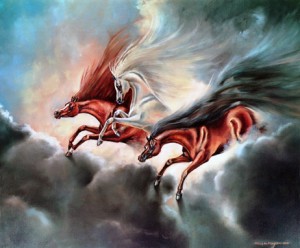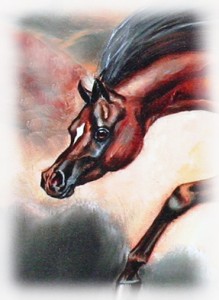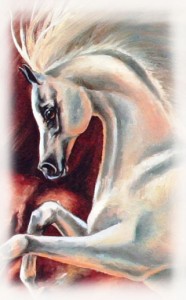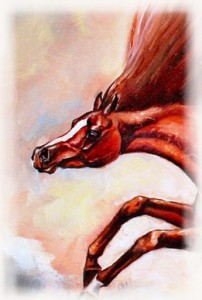For Thursday Art-day we enjoy the mythical themed painting “Born of the South Wind” by Willa Frayser www.willafrayserstudio.com
“MYTHS BRING THE UNKNOWN INTO RELATION WITH THE KNOWN”
Cecil M. Bowra
The Purebred Arabian Horse begins a saga with no recorded beginning – as legend would have, he is born of the south wind – as if he has always been there. You find him etched into the sandstone of the temples of ancient Egypt, extolling his glorious victories, which are a testament to his courage, loyalty and swiftness. The purebred Arabian has a heritage like no other. And as the south wind blows the desert sands across the ages, the tales in each grain praise a horse used for hunting lions, coursing in his chariot, being swifter than the wind and a protector of man…
Stemming from ancient times, Eastern and Bedouin superstitions correspond to the colours attributed to the moon and the seasons. The symbolic words below are aptly portrayed in Willa’s painting.
The Arabs said, “…The horse’s coat must be an index to his character. It is beyond all question that the red mingled with black appearing as deep chestnut is preferred by the Arabs to all others.”
The bay was praised for his vigour, endurance, and strength and is said in the common proverbs: “If you hear that a bay horse fell from the highest mountain and was safe, then believe it.”
The eastern and Bedouin superstitions about colours stem from the most ancient times. In the Bible the prophets refer to them symbolically. “…Behold a white horse: and he that sat on him had a bow; and a crown was given unto him; and he went forth conquering, and to conquer.” White was the principal colour of the new moon, goddess of birth and growth, representing spring.
White was symbolic of victory and success, and the Arabs said: “This is the mount of kings, because it brings good fortune and luck, and with it you are able to obtain what is necessary.” White horses were symbolically sacrificed throughout history and have long been ceremonial favourites.
“And there went out another horse that was red; and the power was given to him that sat thereon to take peace from the earth, and that they should kill one another; and there was given unto him a great sword.” The red horses are said to be symbolic of war and bloodshed.
As the Prophet said: ‘If thou hast a dark chestnut, conduct him to combat.” The Prophet believed: ‘The good fortune of horses is in their chestnut colouring, and the swiftest of all horses is the chestnut horse.” It is said that, “if an ashqar – chestnut was seen flying, then believe so.” Red was the colour attributed to the full moon, godess of love and battle. Symbolically it represented summer.
Adapted from The Classic Arabian Horse by Judith Forbis




2 Responses
Dale
Love these Myths Carmel, no matter how many times I hear them. Thanks for sharing
Carmel Rowley
I love them as well Dale. It’s a thrill to share these stories no matter how many times they are repeated. Really happy you enjoyed the post.Thank you